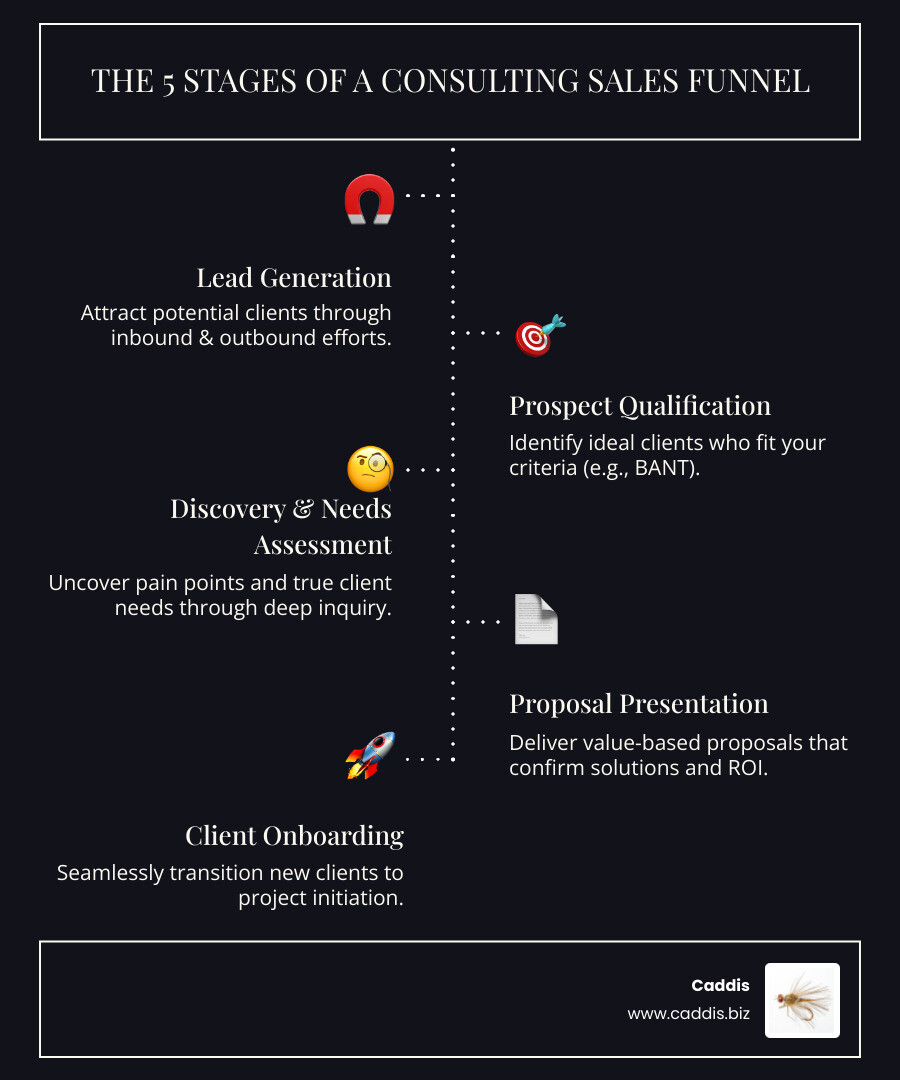From Expert to Rainmaker
A sales strategy for consulting business success requires more than expertise—it demands a systematic approach to turning knowledge into revenue. A winning strategy involves defining your ideal client, building a repeatable sales process, mastering consultative selling, using value-based pricing, and tracking key performance indicators.
The consulting market is booming, with $70.08 billion in expected growth between 2022 and 2027. Yet many brilliant consultants struggle with sales. The challenge isn’t your expertise; it’s that selling intangible services requires a different approach. You’re not just selling a solution—you’re selling yourself and your ability to deliver results.
The good news? Successful consulting sales follows a learnable system. Independent consultants must master both serving clients and finding new ones. This means shifting from an “employee mindset” to a “business owner mindset,” viewing sales not as an interruption, but as a service.
I’m Jeff Mount, and I’ve spent years helping business leaders adapt and execute strategic planning. My experience in sales strategy for consulting business growth has taught me that what worked yesterday probably won’t work today, requiring a patient, adaptive approach.

The Foundation: Mindset, Mission, and Your Ideal Client
The truth about consulting sales is that most of us never planned to be salespeople. We’re experts in our field, not in cold calling. The biggest challenge isn’t learning sales techniques—it’s the mental shift from employee to business owner. When you were an employee, work came to you. Now, you have to find it.
But selling doesn’t have to feel pushy. When you truly believe your expertise can solve a problem, sales becomes service. You’re not just trying to close a deal—you’re trying to help.
Step 1: Cultivate a Winning Sales Mindset
Many consultants face imposter syndrome, questioning their value. But the skills you use in consulting—asking thoughtful questions, listening carefully, and solving problems—are the same skills that make great salespeople.
The key is to shift from “I hope they’ll buy” to “I’m confident I can help.” This isn’t about aggression; it’s about recognizing the value you bring and being comfortable discussing it. Consistency beats intensity. You don’t need to become a sales superstar overnight. Just aim for small, steady improvements. Every conversation helps you refine your approach. For deeper insights into building a strong business foundation, check out our thoughts on business strategy.
Step 2: Define Your Ideal Customer Profile (ICP)
Trying to serve everyone is a recipe for frustration. The most successful consultants have crystal-clear clarity about who they serve best. They know the industry, company size, decision-maker job titles, and the specific problems they solve. This focus makes your sales efforts incredibly effective.
Look at your past successful projects. What patterns emerge? Which clients were most profitable and easiest to work with? Which industries do you understand inside and out?
When you define your ICP, your marketing becomes sharper and your sales conversations flow more naturally. You’ll spend less time educating prospects and more time solving the meaty problems they face. For more insights on strategic targeting, explore our thoughts on business prospecting and strategy.
The Blueprint: Building a Repeatable Sales Strategy for your Consulting Business
With the right mindset and a clear client profile, it’s time to build a repeatable sales process. This is your roadmap from “hello” to “contract signed.” Too many consultants wing it in sales, leading to missed opportunities. A documented system is the difference between struggling and thriving.
Your sales strategy for consulting business success needs core stages: generating leads, qualifying prospects, and crafting winning proposals. Each stage builds on the next, creating a predictable path to revenue. For more insights on developing these essential skills, check out our resources on More info about Sales Skills.
Step 1: Generate a Consistent Flow of Leads
The biggest mistake is only marketing when you need clients. By then, it’s too late. Consistent lead generation requires a mix of inbound marketing (where prospects find you) and outbound prospecting (where you find them).
For inbound, create content that demonstrates your thought leadership and solves problems. For outbound, direct outreach and networking are powerful. Making phone calls gets 16% of consultants their best clients, and Using LinkedIn for outreach is highly effective for B2B. Also, 41% of new clients come from referrals, yet only 12% of firms have a referral strategy. Make it easy for happy clients to send business your way. Pick two or three activities and do them consistently.
Step 2: Qualify Prospects to Focus Your Efforts
Not every lead is a good fit. Chasing every opportunity leads to burnout. Qualify prospects early using the BANT framework: Budget, Authority, Need, and Timeline.
- Budget & Authority: Can they afford your services and approve the expense?
- Need & Timeline: Is their problem urgent and significant?
Ask these qualifying questions early to avoid wasting time. Research shows that 36% of firms create shorter sales cycles through effective qualification. By focusing on high-quality prospects, you’ll close more deals with ideal clients.
Step 3: Craft Proposals That Close Themselves
A proposal should be a confirmation, not a sales pitch. By the time you send it, the prospect should already be on board. Never send a blind proposal; it should feel like the natural next step after thorough findy.
Your proposal must have a clear value proposition. Start with their problem, describe the desired outcome, and show how you’ll get them there. Include an ROI forecast to quantify the value. Offering 3 engagement options (e.g., basic, comprehensive, premium) leverages anchoring bias, encouraging prospects to compare your options rather than your price against competitors. Finally, define specific, timeline-based deliverables. Present it live to answer questions and reinforce the relationship.
The Execution: Mastering Sales Conversations and Follow-ups
Even the best blueprint requires strong execution. Winning new clients often comes down to two skills: asking the right questions and following up with purpose. Your expertise shines brightest when you use it to diagnose a prospect’s true needs before prescribing a solution.
Step 1: Ask Meaningful Questions to Uncover True Needs
The secret to consultative selling is to “diagnose before you prescribe.” Instead of pitching, get genuinely curious about your prospect’s world. When you ask thoughtful, open-ended questions, you build rapport and demonstrate expertise.
Studies show that salespeople who ask between 11 and 14 questions during prospect calls have a success rate of 74 percent. This isn’t an interrogation; it’s active listening to move beyond surface-level issues and understand their real business goals. Great questions help prospects articulate their own pain points, making your services the logical next step.
Step 2: Perfect Your Follow-Up Game
Consider this: 92% of salespeople give up after the 4th call, yet 80% of sales are made between the fifth and twelfth contact. This is a huge opportunity for persistent consultants.
Persistence doesn’t mean being annoying. The key is to add value with every touchpoint. Share a relevant case study, an industry insight, or a thoughtful question. Use multi-channel follow-up (email, LinkedIn, phone calls) to stay top-of-mind. Avoid the dreaded “just checking in” trap. Every follow-up should demonstrate your commitment to solving their problem. When you consistently add value, you’re not interrupting their day—you’re improving it.
The Engine: Tools and Metrics to Manage Your Sales Pipeline
Your sales pipeline is the engine of your business. It needs the right tools and metrics to run smoothly. The right systems don’t complicate your sales strategy for consulting business—they simplify it, freeing you to focus on solving client problems.

Step 1: Choose the Right Tools for the Job
You need a system to track prospects and clients. Whether it’s a Customer Relationship Management (CRM) platform or a well-organized spreadsheet, the best system is the one you’ll actually use.
A simple spreadsheet can work for new consultants. As you grow, a more robust CRM can automate follow-ups and provide detailed reporting. Also consider presentation software for compelling proposals, scheduling software to eliminate back-and-forth, and automation tools for nurturing leads. At Caddis, we help clients implement customized approaches using our SalesQB framework, ensuring tools support your process, not burden it.
Step 2: Track the Metrics That Matter for your consulting business sales strategy
Focus on the metrics that help you make better decisions.
- Conversion rates show where your process is strong and where it’s weak (leads to conversations, conversations to proposals, proposals to clients).
- Sales cycle length is crucial for cash flow planning.
- Average project value helps you track if you’re attracting the right opportunities.
We recommend calculating your “Magic Number” by reverse-engineering your revenue goals. If you want to close $50,000 in new business with a $25,000 average project value and a 25% close rate, you know you need eight quality conversations. This turns a big goal into specific daily actions. A simple weekly pipeline review can transform your business by helping you spot patterns and fix bottlenecks early.
Download the Magic # Exercise Spreadsheet to find how many conversations you need to hit your goals. For deeper insights, check out our thoughts on More info about KPIs.
Frequently Asked Questions about Consulting Sales
Here are answers to the most common questions we hear from consultants building their sales strategy for consulting business success.
How do I price my consulting services effectively?
Pricing is about communicating value, not justifying time. The biggest mistake is charging by the hour, which sells your time instead of outcomes.
Value-based pricing is a game-changer. If your strategy helps a client increase revenue by $500,000, a $50,000 fee is a bargain. Focus on these approaches:
- Project-based fees: Provide certainty for the client and predictable revenue for you.
- Retainers: Work well for ongoing advisory relationships.
- Tiered packages: Let clients choose their level of engagement.
Always discuss outcomes before price. When clients understand the value, the price becomes a secondary concern.
What’s the fastest way to get my first consulting client?
The fastest path is your existing network. Reach out to former colleagues and professional connections. Don’t ask for work directly; let them know what problems you solve and for whom.
Focus on urgent, painful problems that are actively costing a company money. These create the urgency needed to shorten sales cycles. Offer a small, focused project like a strategy audit or process review to reduce their risk and let them experience your expertise. Your first client doesn’t have to be perfect; they just need to be a success story you can build on.
How much time should I dedicate to sales activities?
Avoid the feast-or-famine cycle by making sales a daily habit, not a desperate scramble. Consistent effort, even just 30 minutes a day, is more effective than sporadic bursts of activity.
Aim to spend 20-30% of your time on business development. This may seem like a lot, but it’s essential for a sustainable business. Use time blocking to schedule sales activities just like client meetings. Think of it this way: today’s sales activities fund tomorrow’s security. This perspective makes the time investment a smart business decision.
Propel Your Growth Beyond Strategy
Building a successful sales strategy for consulting business comes down to three fundamental pillars we’ve explored throughout this guide: cultivating the right mindset, creating a repeatable process, and using smart tools to track what matters. The difference between consultants who struggle and those who thrive isn’t talent or expertise – it’s consistent, strategic action.
Think about it this way: you already have the knowledge your clients need. The challenge is connecting that expertise with the people who need it most. That’s where a systematic approach to sales transforms everything.
The mindset shift moves you from viewing sales as a “necessary evil” to seeing it as genuine service. When you truly believe your work solves important problems, conversations become natural extensions of helping, not awkward pitches.
The repeatable process ensures you’re not starting from scratch with each prospect. From lead generation through closing, having clear steps means you can focus on the relationship instead of wondering what comes next.
The right tools and metrics keep you focused on activities that actually drive results. Your “Magic Number” tells you exactly how many conversations you need each week to hit your revenue goals.
Here’s what we’ve learned working with consultants every day: success isn’t about perfection, it’s about consistency. The consultant who makes three calls every morning will outperform the one who makes thirty calls once a month. Small, daily actions compound into significant results over time.
At Caddis, we’ve helped countless financial advisors and small business owners implement these exact strategies. Based in Fairfield, Connecticut, our fractional CRO services and SalesQB framework have guided clients through this change from hoping for clients to systematically attracting them.
The consulting market’s growth isn’t slowing down, and there’s room for your expertise. But waiting for clients to find you isn’t a strategy – it’s a hope. The systematic approach we’ve outlined here works because it’s based on understanding human psychology, building genuine relationships, and delivering real value.
If you’re ready to stop leaving revenue to chance and start building a predictable pipeline, we’re here to help you implement every piece of this strategy.
Get expert help implementing your sales strategy with a Fractional CRO





